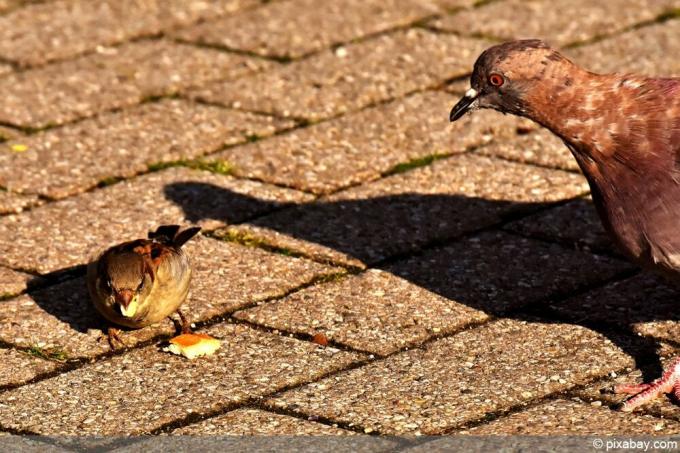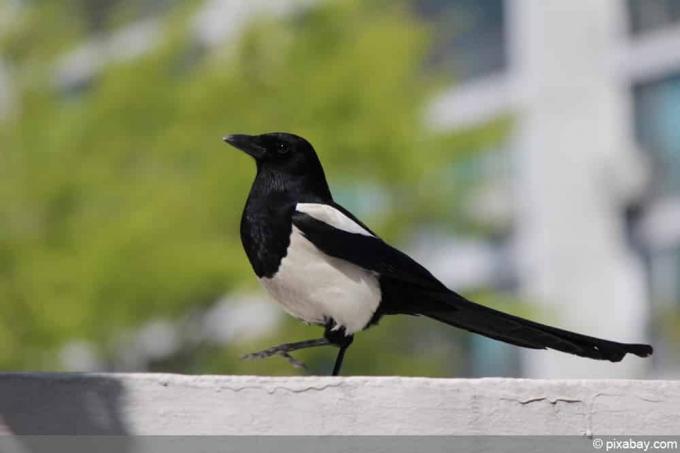

Table of contents
- recognize martens
- Preferred habitats
- controls and order
- Sounds
- brightness
- movements
- odors and fragrance
- Eliminate food sources
- Water
- Tips for the car
If a marten has moved in, many unpleasant surprises must be expected. Gnawed wires and brakes, excrement and urine in the attic, butchered prey in the garden - the list goes on and on. So that the extent of the damage can be limited, action should be taken quickly. What martens don't like or even hate, we reveal here.
recognize martens
Recognizing the signs of an infestation is crucial to driving out the martens in a targeted manner. The nimble animals themselves are rarely caught in the act. Once they have moved in, however, there are typical indications of their presence. This includes, among other things:
The nest
The nest consists of soft materials such as feathers, strips of fabric and padding, for example. But hay and straw can also be found in it.
markings
The animals mark their territory extensively with feces and urine. Especially in summer or in warm rooms, this can represent a significant odor nuisance. The droppings are visible to the naked eye, while urine stains can be made visible using appropriate UV lamps. This is important in order to be able to treat and remove them later.
uneaten food
It usually eats the marten's prey near the nest, which means that the remains are also found here. Bones, claws, teeth, feathers and fur can be noticeable. As with the markings, the leftovers can give rise to an intense odor. An intense smell of decay must be expected, especially with leftover meat.
Preferred habitats

In order to be able to deter and drive away the unwanted roommates in a targeted manner, the preferred habitats of the martens must be known in addition to the way of life. These include:
Quiet rooms in the house
Rarely used and quiet rooms in the house are among the martens' favorite accommodations. Above all attics, but also basements, storage rooms and garages are often used as shelters by the dog-like predators. The quieter and darker the rooms are, the more popular they are. An attic with many boxes and crates that is rarely visited by people is therefore ideal for the small animals.
Garden
Piles of wood on the house wall, garden sheds, tool sheds - the garden also offers some potential hiding places and habitats for the wild relatives of ferrets. If the garden is not visited daily and is therefore generally quiet, the risk of it becoming a home for marten families increases.
cars
Although the predators do not settle permanently in cars, they do offer protection and warmth and are therefore popular with martens. This can be expensive for the driver or even dangerous, because marten damage to the brakes and lines is not uncommon. In order to drive martens out of storage and living spaces or the garden, these areas should be designed as habitats for the animals to deter them.
controls and order
Because the small predators feel most comfortable when they are undisturbed by people and pets, can Regular checks already help to identify an infestation as quickly as possible and to protect the animals drive out. The following tips are simple but effective:
- Check otherwise unused rooms at least once a week
- Turn on the light and air the room
- illuminate dark corners and niches with a flashlight
- Organize storage rooms and other storage areas as well as possible so that the animals find fewer hiding places
It is also ideal if noises are also made to deter people during the checks.
Sounds

Since martens prefer quiet areas that are rarely frequented by people and pets, "noise" can be a downright deterrent. Here again, there are simple measures:
- play music
- regularly chop the garden, mow the lawn or let pets and children play
- Play recorded animal sounds of cats or dogs
- install defense systems on the car (or have them installed) that emit high-frequency noises either at regular intervals or through a motion detector
brightness
As crepuscular or nocturnal animals, martens shy away from the light. Since they don't like bright and glaring light sources in particular, they can be used wonderfully as a deterrent.
- Switch on the light regularly in otherwise unused rooms
- Use timers to leave lights on at night
- Use motion detectors that only turn on the light when the animals are active
- illuminate dark corners with a flashlight
In this way, the predators are caught again and again when they want to make themselves at home and are driven away as a result. The use of light or lamps can also be wonderful for the garden and other outdoor areas. You don't have to put a lot of effort into it. Simple lights with a motion detector can be placed almost anywhere and run on batteries. This can also protect the car from marten damage, for example, and the garden can be made unattractive for the animals.
movements
Martens are shy and quick and can therefore be driven away comparatively quickly by movements, because they quickly suspect a danger behind them. They also hate restlessness. Again, simple changes are enough to take advantage of movement and drive the animals away.
rearrange
On the one hand, when rearranging areas that are otherwise rarely used, the first tracks of the animals are already noticeable. On the other hand, the area becomes less attractive for the animals. Of course, it doesn't really have to be rearranged, pushing and briefly lifting larger objects and walking in the rooms is usually enough.
children and pets
Playing by children and pets is an ideal deterrent both in living spaces and in the garden. Anyone who has neither children nor pets can help themselves out with a marten infestation by visiting them accordingly.
move car
If the car is rarely used and is also outdoors, it can quickly become a victim of marten damage. It is better to at least switch on the engine and, if necessary, roll a few meters or, above all, to open and close doors in the evening and in the morning. These movements make the car less attractive to the animals.
Clean and tidy up
Indoors, even simple cleaning and tidying up can help make the space deterrent to animals. Vacuum cleaning, the use of cleaning agents with a lavender scent and avoiding confusing corners bring movement into the room. On the other hand, sounds and smells are also used to keep the canine predators away.
odors and fragrance

Martens perceive various smells as a deterrent and can therefore be used to drive the animals away. These funds are suitable for both exterior and interior use and for protecting the car:
cats
Used cat litter, brushed fur and feces can be used. The scent marks of the cats act as a marker for predators and ensure that martens run away.
dogs
As with cats, dogs' scent marks can also have a deterrent effect. If you don't keep a dog yourself, you can, for example, invite dog owners or ask friendly owners for "scent samples". Again, brushed fur, blankets and faeces are well suited to deter predators.
bears
This measure may seem unusual, but experience has shown that it is excellent for driving away martens. Bear urine and fur can be used to deter predators. Bear urine can be purchased commercially, as the smell is also used to scare off other wild animals. Untreated fur may be available at the zoo if necessary. It's worth asking here.
Herbs
The scent of herbs such as lavender and citronella is said to keep the small predators away. The advantage of this method is that the scent or smell is quite pleasant for human noses. In addition, the lavender and Co. can be planted fresh in the garden, on the windowsill, but also dried and scattered in the house or on the car.
special sprays
Special repellent sprays also use fragrances and mixtures thereof to act as a deterrent. They work immediately and with little effort and can be used both indoors and outdoors.
Eliminate food sources
In addition to quiet, dark places, nearby food sources are also attractive. This includes food leftovers in the garbage but also bird nests. The following tips can help make them inaccessible:
- Protect trees against cats and martens, for example with a ring of spikes on the trunk
- Hang up bird baths, bird feeders and nesting boxes at a safe height and protect them from climbing animals
- Make trash cans burglar-proof
Water
Sprinkler systems with motion detectors can be particularly suitable for the garden. These can also be used on paths and around the car, for example, and only come on when an animal walks through the sensor of the motion detector. The advantage of this is that the plants are also watered at the same time. The downside is that it can also scare off potentially useful animals and potentially waste a lot of water, at least initially. However, water is definitely suitable for selective use, since the predators hate the wet.
Tips for the car

So that the car is not damaged by martens, it should be well protected. One possibility is the (subsequent) installation of a protection system that generates deterrent sounds for marten ears. Another option is a grille or a special protective mat under the hood. Since the animals do not like to move on grids and metal surfaces, penetration into the engine compartment through the mats or grids is avoided.
 garden editorial
garden editorial I write about everything that interests me in my garden.
Learn more about animal defense

Bird repellent: with these means you drive birds away from the balcony
Pigeons, sparrows and many other bird species often choose a balcony as a resting or even nesting place in the city. However, to ensure that your own balcony is spared bird droppings in particular, there are various measures that can be used effectively here without harming the animals.

Scare away foxes from the garden and keep them away
Whether in the city or in the country - more and more hobby gardeners meet foxes in their own green kingdom and ask themselves how they can scare them away. We have summarized which measures are best suited for this in this article!

Prevent birds under roof tiles and roof overhang
If birds settle under the roof tiles and the roof overhang, this can lead to damage to the building fabric. The droppings cause unsightly dirt, and breeding songbirds make a lot of noise. Various countermeasures have proven effective in preventing unwanted colonization.

Remove sparrow nest under the roof
Where people live, sparrows are not far either. With a few exceptions, this applies all over the world. Sparrows are cultural followers, they have adapted to the way of life of humans. What to do if sparrows breed under the house roof?

Recognizing magpie droppings | Magpie droppings with picture
Bird droppings on the terrace or on the light wall of the house are a nuisance. What culprit is behind this? Was it the magpies? We'll show you how to spot magpie droppings and how to get rid of them.

Recognize badger droppings in the garden: 6 characteristics
Have you ever seen a badger in the wild? The animals with the black stripes on their faces are common in German forests. She is increasingly drawn to the city. Their legacies are annoying. How can badger droppings be identified?
